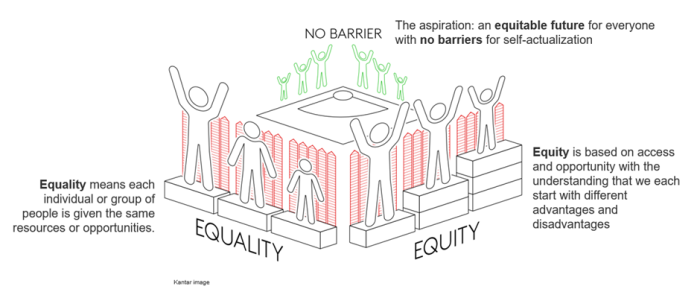Get analysis, insight & opinions from the world's top marketers.
Sign up to our newsletter.
Seven of WFA’s strategic partners reflect on what will define marketing for the year ahead

Clockwise from top left: Maddy Cooper (Brilliant Noise), Paul Kemp-Robertson (Contagious), Lucinda Peniston-Baines (The Observatory International), Valeria Piaggio (Kantar), Robin Seasock (Decideware), Magid Souhami (Global Data Bank), Matt Wardle (OxfordSM)
WFA asked industry experts from seven of its strategic partners Brilliant Noise, Contagious, Decideware, Global Data Bank, Kantar, Oxford SM and The Observatory International to identify the trends that will shape the marketing industry this year.
Maddy Cooper, Founding Partner and Chief Commercial Officer, Brilliant Noise:
At long last, 2022 will be the year we see every marketing leader take meaningful action towards fulfilling their Planet Pledge and transforming their brands and marketing teams to be fit for the age of sustainability.
Along with the climate, consumer needs are changing faster than ever, and brands that want to stay relevant need to get their sustainable story straight.
Green can mean growth. For the FMCG category alone, sustainability is forecast to bring $382 billion to brands. Why? Because sustainability and transparency are what consumers want. Right now.
But sustainability creates a wicked problem for marketers: How can you reach the holy green grail of investing in sustainability transformation and creating genuine positive change for our planet, all while growing your brand by winning the hearts of conscious consumers and securing your relevance for the future? Wicked indeed, but we’re having a lot of fun proving that it’s possible.
Paul Kemp-Robertson, Co-founder & Chief Brand Officer, Contagious:
Last year, Contagious predicted that marketers would need to act as Impresarios and Ideologists – sprinkling magic dust into retail and events, and acknowledging that capitalism requires a fundamental reset.
Those roles still hold true. But in 2022, marketers need to add the task of being ‘Inquisitives’ – to treat the months ahead as an opportunity for discovery, because the immediate future now has a different roadmap.
The pandemic has created a hybrid universe. We’re conditioned to work, play and learn virtually. This has accelerated the three tech trends most searched for on the Contagious intelligence platform: Web3; NFTs, and the Metaverse.
Web3 is a decentralised internet, driven by new cultural, economic and governance models that place control in the hands of creators rather than corporates. It is powered by tokens, including non-fungibles. These NFTs are unique digital certificates, stored on the blockchain that signify the ownership of a particular digital asset. They will enable the Metaverse - described by Mark Zuckerberg as an ‘embodied internet’ - to become a functioning economy.
If that fills your head with questions, then great. That’s exactly my point. 2022 is a frontier year. No one has all the answers yet, which means intelligent questions are worth their weight in gold. So, go be inquisitive.
Lucinda Peniston-Baines, Co-founder and Managing Partner, Observatory International:
Brands’ increasing focus on data-driven communication is influencing the convergence of data, creative, media and content optimisation skills in agency rosters. And with digital content creation an increasingly important engine, we are seeing an “inside-out” model emerging with digital-first at the heart of the process rather than a link in a linear development process.
Implications for traditional ‘big idea’ agencies, long used to a “Lead Agency” role, are profound as they redefine their role and influence in the agency ecosystem as originators of high-level brand platforms rather than executors of most assets needed. Marketers must evolve to be at the centre of deploying this asset engine, orchestrating content creation and deployment and responding to data and insights to drive real-time relevance. Effective deployment of this type of model can also contribute to a brand’s sustainability targets.
These are major shifts in roles and ways of working for all parties and will need careful recalibration.
Valeria Piaggio, Global Head of Kantar Inclusion, Kantar:
Over the last decade, consumers have been pushing businesses to improve their diversity and inclusion efforts – and brands have responded. But with 8 in 10 consumers today expecting businesses to play a role in making society fairer (Kantar U.S. MONITOR 2021), equity is the next frontier for brands seeking growth in a more diverse marketplace.
Equity is the future of inclusion marketing. Several companies and brands have entered diversity and inclusion, but not many have tackled equity. Equity means providing each individual fair opportunities to reach their full potential and requires recognizing systemic barriers. Pushing for equity demands a lot more brand bravery and commitment, it’s more focused on actions than statements. In advertising, equity is about representation: giving under-represented people a chance to tell and view their own stories. In practical terms, it’s about investing in untold stories and hiring diverse creative talent to bring those stories to life.

Robin Seasock, Chief Operating Officer, Decideware:
Advertisers will adopt technology at an accelerated pace in 2022 and, those companies that were early adopters will widen the gap between themselves and their competitors. Over the last two years, advertisers were forced to pivot and shift their approaches to marketing – some companies were prepared, others were caught off guard and struggled. The advertisers that will thrive in the future will adapt based on superior access to data and insights.
Accelerated channel fragmentation, talent shortages, more specialty capabilities, and the need to quickly adjust strategy and tactics will drive technology adoption. Marketing will leverage their internal allies in procurement, information technology, and finance to support greater automation and increased transparency into marketing operations. The early adopters will think beyond the efficiency benefits and use business intelligence to capture meaningful insights that inform strategies and influence marketing decisions.
Magid Souhami, International President, Global Data Bank:
With the end of third-party cookies, brands will need to adopt newer, more sustainable approaches to data-driven marketing. Key changes and trends we are seeing in this space include:
2022 will see a reinvention of data-driven marketing, one which will put data ethics and a fair data value exchange at the heart of the brand-customer relationship.
Matt Wardle, Head of Capability, North America, OxfordSM:
After the work and life challenges of the past twenty-four months, 2022 will hopefully be the year when teams can physically meet and collaborate again. But what will working and learning look like after the initial novelty of rediscovering meeting rooms, flipcharts and post-it notes? In other words, what would a well-functioning, fulfilling and holistic hybrid approach look like?
Ideally, it will combine the improvements in remote working with the dynamism of in-person collaboration. It will enable a hybrid of connection and concentration: meeting to discuss projects, share ideas and network – or the flexibility to focus in your own space (and pace). It will blend working and learning: teams collaborating on outputs in real time, with training or guidance just a click away. And a fit-for-purpose approach to workshops and events: choosing the efficiency of virtual sessions, or the engagement of being together. After the innovation and effort that has gone into remote working over the last two years, the prospect of hybrid working – that works – might be on the horizon.